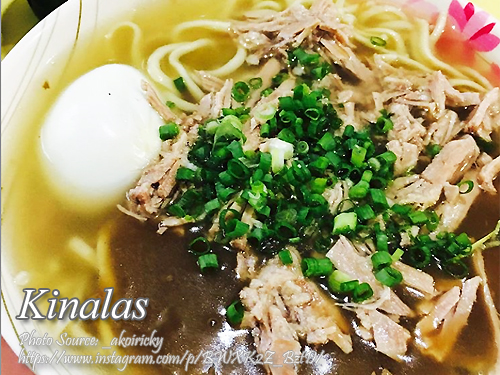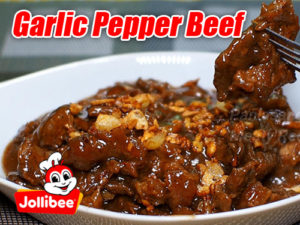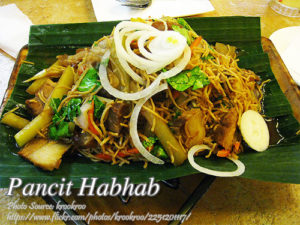Kinalas is famous noodle dish in Naga city. It is very similar to beef mami and the only thing you will notice on their difference is the addition of thick brown sauce on top of the noodles similar to a gravy. If you haven’t heard of this dish, you might wonder why it is called “kinalas” because it doesn’t sound like a noodle dish. When I first known this dish, I thought it was the dialect thinking it is equivalent to beef mami or bulalo mami.
But my assumption is wrong because that word means to scrape or remove the meat from the bones. Which is the method of cooking this dish. The traditional way of making this is using cow’s head and boiling it until the meat almost separate from the bones. Then the meat and tendons are removed from the bones and chop it to bite size pieces and used as a garnish. The cow brains is also included in the dish. It is used to thickened the sauce. But in the recipe below, we only used flour to thicken the sauce.
Kinalas: A Taste of Naga’s Heritage in a Bowl
The first time I read that word, I did not know what to expect. Even the name itself was unfamiliar:. Since growing up with bulalo and beef mami, I just assume it as another version of noodle soup. That is until I met my cousins in Naga where things are different.
My uncle would say that it actually means scraping or detaching the meat from the bones, which is exactly how this iconic dish is prepared. Traditionally, the cow’s head is simmered for hours until the meat nearly falls off the bone. The long-simmered beef, so juicy and tender it just melts in your mouth, is placed on a bed of noodles and drenched with this rich, savory sauce-a true blend that is hearty, flavorful, and definitively Naga. In the past years, the dish might have evolved; however, its intrinsic essence remains the same: a comforting bowl to bring people together.
Unique Noodle Experience
If you have ever tried beef mami or bulalo mami, then the basics of kinalas will be familiar, but what gives the dish a marked distinction from the others is its rich gravy sauce poured over mountains of noodles. Traditionally thickened with mashed cow brains, it’s what gives the dish that deep, almost umami flavor. Don’t worry, however, because modern recipes-such as the one I am sharing with you today-use flour instead, making it much easier to reproduce in your home kitchen without having to go out of your way to search out more exotic ingredients.
For a beginner or someone who might not have tried this dish before, the soup is a savory and rich broth similar to the beef mami but with some added layers of depth developed from slow cooking the beef shank. Of course, the patience about the key. Patience in making this broth and attenuation of its meat towards the perfect tenderness.
A Bowl of History
Kinalas is a sort of staple in Naga City. Through time, it became the flavor that the city understood and appreciated, characterized by hearty portions. This favorite of the locals is found in small eateries called “karinderias” spread throughout the city. At times, preparation is said to be done differently, but its essence is preserved in its original flavor. It takes time and patience to make it, much like the warmth of a family gathered together eating simple home-cooked meals with style.
From such origins, it evolved from the common utilization of parts of the cow that used to be wasted-considering the all-from-head-to-tail practice-a really practical and thrifty way of boiling the cow’s head until the meat would finally be soft and scraped out of the bones. In this dish, no part of the animal went to waste. Today, the dish is still a favorite comfort food, especially on rainy days when all that you want is a warm, savory soup to soothe your soul.
Cooking Kinalas at Home: A Family Tradition
As my sister-in-law reminisced about her trip back to Naga, I could not help but listen in. Her stories were so enticing that I considered making it at home. Of course, this will have to go through the tips I learned from my uncle. I cooked it in the traditional way: slow, slow cooking of the beef shank for hours and hours, to draw the deep, deep flavors of meat and bones into the dish. The kitchen filled with the rich aroma of simmering broth. That familiar fragrance took me back to family gatherings at the houses of relatives and back into memories of my childhood.
I have always believed that a good kinalas is only prepared in broth, as my uncle once said. The broth takes time: time to extract all the flavor from the bones, time to let the beef reach that melt-in-your-mouth texture. It was just a matter of waiting when the broth is ready for me to scrape the meat off the bones—the very act that defines this dish.
The sauce, in itself a labor of love, begins its life as an ancient concoction thickened by cow brains; with modern recipes such as mine, all that part is omitted and the sauce is fashioned simply with flour into a roux. Do not omit this step: browning the flour before adding it to the sauce adds nutty flavors and a slightly rich taste for everything. A few dashes of shrimp stock cube add an unexpected umami hit, leaving the dish alive.
Serving and Relishing
Serve: heaped generous mounds of noodles into each bowl and top with the tender beef. Spoon over the thickened sauce, then ladle that richly flavored broth over everything. Garnish spring onions, a few slices of hard-boiled egg, and crispy fried garlic to add that irresistible crunch. Just before you dig in, give it a squeeze of calamansi for the bright, zesty contrast to the deep, savory flavors.
When I cook kinalas, I always imagine my family and a warm family meal shared all around the table. It is more than a meal; it’s the symbol of what we carry in our traditions-practiced from generation to generation, and it feels cozy to recognize a well-loved dish.
So the next time that you crave something comfortingly delicious, try it. Be it your first time to make or you’ve had it and liked it in the past, this noodle soup is guaranteed to warm the heart and fill the belly as it has done for generations in Naga.
Kinalas
Ingredients
- 500 grams egg noodles or fresh miki noodles
- 2 kilos beef shank bones-in with tendons
- 1 Tbsp. black peppercorns cracked
- 1 Tbsp. rock salt
- 2 pcs red onions quartered
- 1 liter water for boiling
For kinalas sauce:
- 1/2 cup all-purpose flour
- 2 Tbsp. soy sauce
- 2 Tbsp. vinegar
- 1 Tbsp. sesame seed oil
- 4 Tbsp. dried shrimps grind until powdered
- 1 pc shrimp cube
- 3 to 4 cups water or beef shank broth
- 2 Tbsp. patis fish sauce
Garnishing
- sliced garlic fried
- spring onions chopped
- boiled eggs sliced
- sliced calamansi
Instructions
How to cook Kinalas:
- Put beef shank and water in a pot just enough to cover the meat and bring it to a boil. Continue boiling for about 3 minutes and turn off heat. Discard the liquid and rinse with tap water. Drain.
- Put a liter of water in the pot containing the beef shank and add the black pepper, salt and onions. Bring to a boil and simmer for 2 hours. Remove the scum while cooking the beef. Add more water if necessary as it may dry up the soup stock which you will use later for the kinalas broth.
- Remove the beef shank from the broth and place in a bowl to let it cool. When cooled, remove the meat and tendons from the bones and scrape whatever is left sticking in the bones. This procedure is known as "kinalas" separating the meat from the bones.
- Chop the meat into bite size pieces and set aside.
To make the sauce:
- Heat a skillet and lightly brown the flour for a few minutes. Remove from the skillet and set aside.
- In saucepan, combine all the rest of kinalas sauce ingredients and the flour and stir until the flour is dissolved.
- Bring to a boil until the sauce is thickened and the shrimp cube is dissolved.
To assemble the kinalas:
- Cook the egg noodles according to package directions. If you are using fresh mami or miki noodles, just soak it in hot water for a few seconds and drain.
- Put and divide the noodles in serving bowls and put some sliced beef. Pour the kinalas sauce about 3 tablespoons and pour the beef shank broth. Garnish with boiled eggs, spring onions and fried garlic. Serve hot and serve with calamansi.
Notes
Cooking Tips:
Simmer the Beef for Full Flavor
The final preparation step when preparing beef shank is patience. Simmer beef over low-heat for at least two hours or more to deep, rich flavors from your bones and meat come out. Do not allow any scum to form and rise on top; skim this off to keep the broth clean and clear of flavor.Browning the Flour for a More Intense Sauce
It takes some time to lightly brown the flour in a skillet before adding it to the sauce. This is done to achieve a subtle nutty flavor that gives your dish a well-rounded flavor and texture. Meanwhile, do not cease stirring so it won't burn and will have an even color at gold.Add the Calamansi Right Before Serving
For a burst of brightness, squeeze some fresh calamansi over the dish just before serving. The citrusy tang balances the richness of the beef and the sauce, making it more rounded in taste. Just be careful not to add it too early as the heat tends to muddle up the fresh zesty notes.





